Yaesu Musen HX260S VHF HAND HELD RADIO TRANSMITTER User Manual HX260S DFU
Yaesu Musen Co., Ltd. VHF HAND HELD RADIO TRANSMITTER HX260S DFU
Contents
- 1. owners manual A
- 2. owners manual B
owners manual A
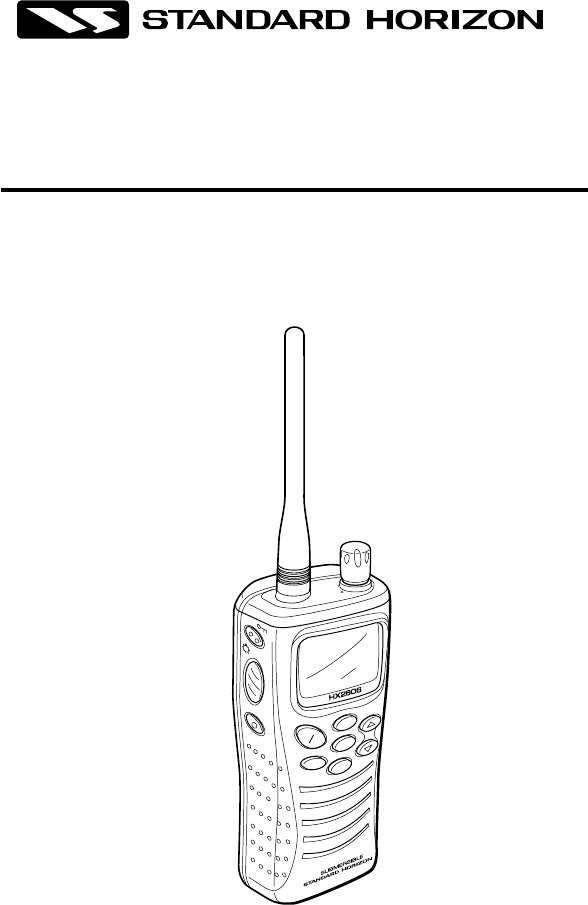
HX260S
VHF/FM Marine
Handheld Transceiver
Owner’s Manual
DW
16 9
SCAN
H/L
WX
SQL
VOL
OFF

page 24 Owner’s Manual HX260S
TABLE OF CONTENTS
FCC NOTICE .......................................................................................................... 1
1 GENERAL INFORMATION .............................................................................. 2
1.1 INTRODUCTION .............................................................................................. 2
1.2 FCC/ INDUSTRY CANADA INFORMATION .................................................... 2
2 ACCESSORIES ............................................................................................... 3
2.1 PACKING LIST ................................................................................................. 3
2.2 OPTIONS ......................................................................................................... 3
2.3 REPLACEMENT PARTS .................................................................................. 3
3 CONTROLS AND INDICATORS ..................................................................... 4
3.1 CONTROLS AND CONNECTIONS ................................................................. 4
3.2 INDICATORS ................................................................................................... 8
4 OPERATION .................................................................................................. 10
4.1 INITIAL PROCEDURE ................................................................................... 10
4.2 RECEPTION ................................................................................................... 11
4.3 TRANSMISSION ............................................................................................ 12
4.4 TRANSMIT TIME - OUT TIMER (TOT) .......................................................... 12
4.5 SIMPLEX/DUPLEX CHANNEL USE .............................................................. 13
4.6 USA, CANADA, AND INTERNATIONAL MODE ............................................ 13
4.7 NOAA WEATHER CHANNELS ...................................................................... 13
4.8 WEATHER ALERT ......................................................................................... 14
4.9 MEMORY SCANNING .................................................................................... 14
4.10 DUAL WATCHING ........................................................................................ 15
4.11 EMERGENCY CHANNEL 16 ........................................................................ 15
4.12 CHANNEL 9 .................................................................................................. 15
4.13 OPERATING ON CHANNEL 13 ................................................................... 15
4.14 OPERATING ON CHANNEL 67 ................................................................... 16
4.15 RESETTING THE TRANSCEIVER’S MICROPROCESSOR ....................... 16
5 BATTERY ....................................................................................................... 17
5.1 BATTERY CHARGING ................................................................................... 17
5.2 BATTERY PACK REMOVAL/INSTALLATION ............................................... 17
5.3 USING BATTERY TRAY ................................................................................ 18
5.3 OPERATING CWC260 BATTERY CHARGER ............................................... 18
5.4 BATTERY SAFETY ........................................................................................ 19
6 MAINTENANCE ............................................................................................. 20
7 SPECIFICATIONS ......................................................................................... 21
7.1 GENERAL ...................................................................................................... 21
7.2 TRANSMITTER .............................................................................................. 21
7.3 RECEIVER ..................................................................................................... 21

HX260S Owner’s Manual page 1
FCC NOTICE
NOTICE
Unauthorized changes or modifications to this equipment may void
compliance with FCC Rules. Any change or modification must be
approved in writing by STANDARD HORIZON, a division of YAESU USA.
NOTICE
This equipment has been tested and found to comply with the limits for
a Class B digital device, pursuant to Part 15 of the FCC Rules. These
limits are designed to provide reasonable protection against harmful
interference in a residential installation. This equipment generates,
uses and can radiate radio frequency energy and, if not installed and
used in accordance with the instructions, may cause harmful
interference to radio communications. However, there is no guarantee
that interference will not occur in a particular installation. If this
equipment does cause harmful interference to radio or television
reception, which can be determined by turning the equipment off and
on, the user is encouraged to try to correct the interference by one or
more of the following measures:
— Increase the separation between the equipment and receiver.
— Connect the equipment into an outlet on a circuit different from
that to which the receiver is connected.
— Consult the dealer or an experienced marine electronicstechnician
for help.

page 2 Owner’s Manual HX260S
1 GENERAL INFORMATION
1.1 INTRODUCTION
The STANDARD HORIZON (a division of YAESU USA) HX260S is a
marine handheld two-way VHF transceiver. The transceiver has 65
channels: 55 marine and 10 weather. The 55 marine channels are
switchable to comply with either USA, International, or Canadian
regulations. It has an emergency channel 16 which can be immediately
selected from any channel by pressing the red 16/9 key. Weather channels
can also be accessed immediately by pressing the WX key.
The transceiver includes the following features: memory scanning, dual
watch, weather alert, battery saver, easy-to-read large LCD display,
EEPROM memory back-up, battery life displayed on LCD, and a transmit
Time-Out Timer (TOT).
1.2 FCC/ INDUSTRY CANADA INFORMATION
The following data pertaining to the transceiver is necessary to fill out the
license application.
FCC Type Accepted ........................................................................ Part 80
Output Power with CNB260 battery ................... 1 watt
(Low)
and 5 watts
(High)
Emission...................................................................................... 16K0G3E
Frequency Range ............................................... 156.025 to 163.275 MHz
FCC Type Number ..................................................................K66HX260S
Industry Canada Type Approval ................................................ PENDING
Additional FCC and Industry Canada data, including licensing
requirements, are contained in the companion document titled
OWNER’S MANUAL SUPPLEMENT. The document also contains
charts for VHF channel assignments, transceiver operating
procedures, maintenance, factory service information, and
warranty data.

HX260S Owner’s Manual page 3
2 ACCESSORIES
2.1 PACKING LIST
When the package containing the transceiver is first opened, please check
it for the following contents, notify the dealer if you are missing any of these
contents.
• HX260S Transceiver
• CNB260 Rechargeable Battery Pack (Ni-Cad 7.2V, 750 mAh)
• CAT350 Flexible Antenna with STUD connector
• CWC260120V AC Wall charger
• Battery Tray for “AA” alkaline battery
• Lanyard
• Belt Clip with screws
• Owner’s Manual
• Owner’s Manual Supplement
2.2 OPTIONS
CAW350 ................................................... Radio to ships antenna adapter
CMC240 .................................................................. 12VDC-trickle charger
MCC260 ....................................................................................Nylon case
2.3 REPLACEMENT PARTS
Flexible Antenna with STUD Connector ....................................... CAT350
Rechargeable Battery Pack .......................................................... CNB260
Belt Clip ......................................................................................................
Lanyard .................................................................................. 458C156040
Volume Control Knob .................................................................................
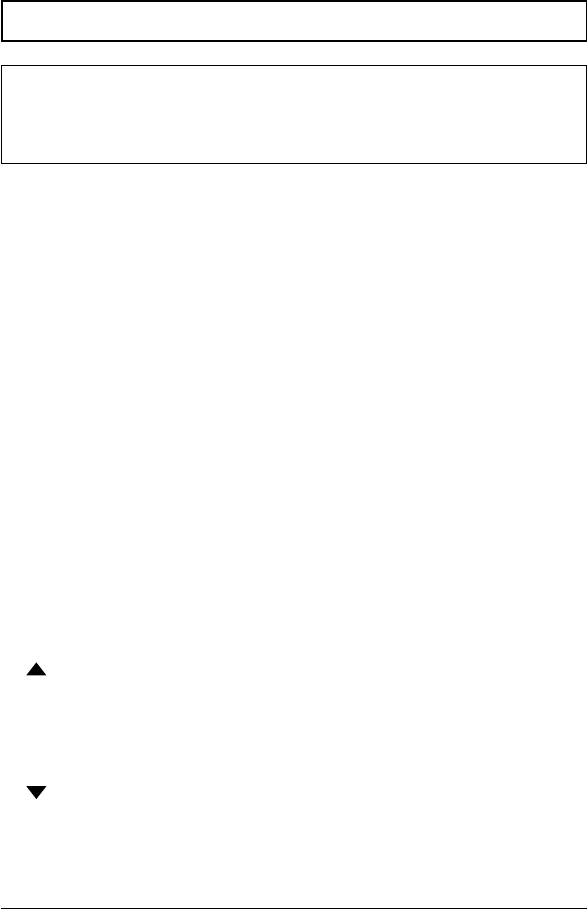
page 4 Owner’s Manual HX260S
3 CONTROLS AND INDICATORS
NOTE
This section defines each control of the transceiver. For detailed
operating instructions refer to section 4 of this manual.
Refer to Figure 1 for the location of the following controls, indicators,
and connections.
3.1 CONTROLS AND CONNECTIONS
q POWER SWITCH/VOLUME CONTROL
Turns the transceiver on and off and sets the audio volume. To turn the
transceiver on, turn this knob clockwise until the LCD turn on. When
power is turned on, the transceiver is set to last selected channel.
Secondary use
When the transceiver is turned on while the SCAN and WX keys are
held down, the internal microprocessor is reset. This clears memory
and all user-programmed settings, such as scan memory, priority scan
assignments. This is known as the default condition, the same as when
shipped from the factory. For a list of these defaults, see the section on
resetting the Transceiver’s Microprocessor.
w DW KEY
Watches for a transmission on CH16 and another selected channel until
either signal is received.
e (Up) KEY
Selects the desired channel and adjusts the squelch level. Each press
increases the channel number or squelch level. When held down, the
channels or squelch levels increase continuously.
r (Down) KEY
Selects the desired channel and adjusts the squelch level. Each press
decreases the channel number or squelch level. When held down, the
channels or squelch levels decrease continuously.
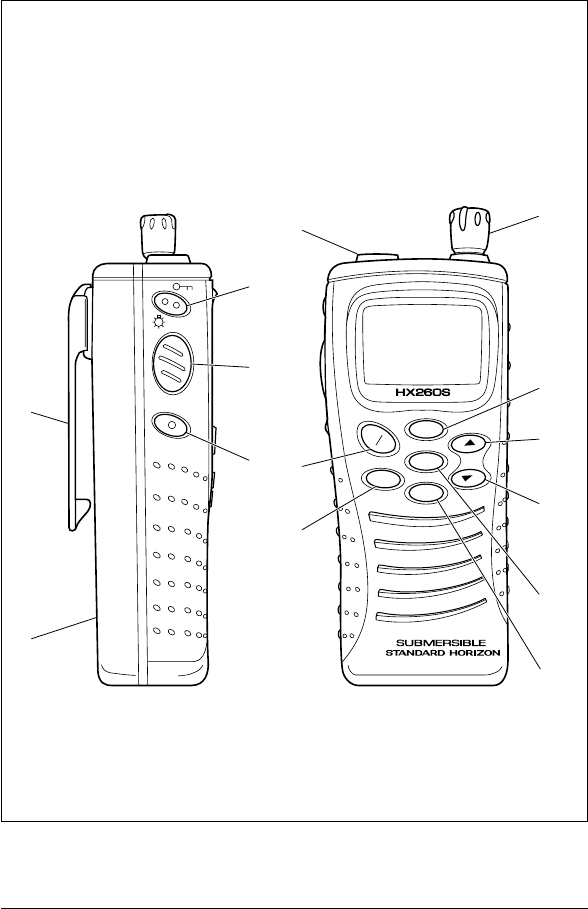
HX260S Owner’s Manual page 5
Figure 1. Controls and Connectors
SCAN
H
/
L
DW
WX
16 9
SQL
q
w
e
r
t
y
u
i
o
!0
!1
!2
!4
!3

page 6 Owner’s Manual HX260S
t SCAN KEY
Memory SCAN
1. Press once to start or stop scanning programmed channels.
2. If held while pressing the UP or DOWN key, the radio will show the
programmed channels in scan memory.
NOTE
This function will not work if the radio is scanning.
Secondary use
Press and hold to store the selected channel into the transceiver’s scan
memory for scanning. Press and hold down the SCAN key again to
store or delete a channel from the scan memory.
y H/L KEY
Toggles between high (5 watts) and low (1 watt) transmit output power.
Does not operate on “low power only” and transmission-inhibit channels.
When this key is pressed while the transceiver is on channel 13 or 67, the
power will temporarily go high when the PTT switch is pressed. When the
PTT switch is released the power setting reverts to low.
u WX KEY
Immediately recalls last selected weather channel.
Secondary use
1. Holding down the 16/9 key while pressing the WX key, changes the
mode from USA to International or Canadian.
2. Holding down the WX and SCAN key while turning the power on,
resets the microprocessor and erases scan channels from memory.
This clears the memory and establishes the factory-set defaults. For a
list of these defaults, see the section on resetting the Transceiver’s
Microprocessor.
i 16/9 KEY
Immediately recalls channel 16 from any channel location. Holding
down this key recalls channel 9.
Secondary use
Please see secondary use for the WX key and the SCAN key.
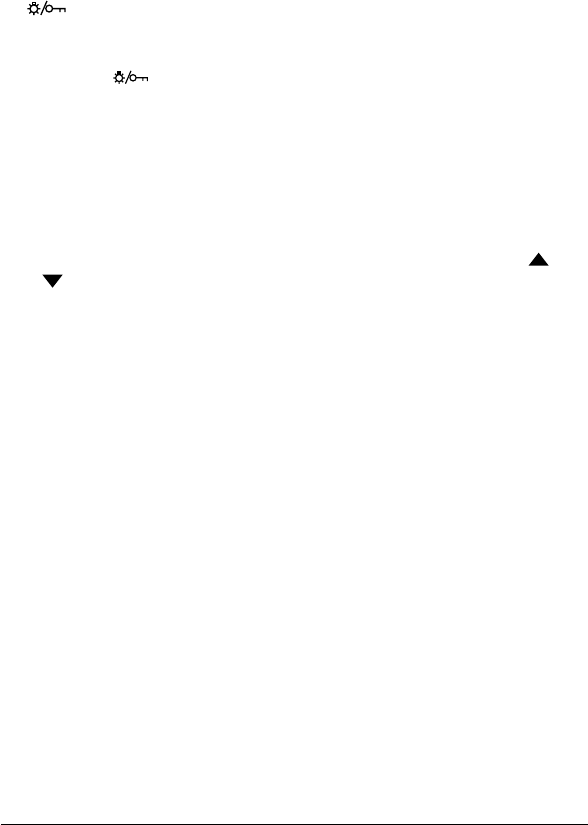
HX260S Owner’s Manual page 7
o Antenna Connector
Connects to the flexible antenna CAT350.
!0 (lamp/key lock) KEY
Single depression of this key, turns on or off the backlite for the LCD and
Keys. When pressed and held locks the keypad buttons except for the
SQL, H/L, (lamp/key lock) and PTT.
!1 PUSH-TO-TALK (PTT) SWITCH
Activates transmission and show TX indicator on the display.
!2 SQL (SQUELCH CONTROL )
Activates the squelch adjusting mode.
Press this key to activate the squelch adjusting mode. Press the (Up)
or (Down) key to adjust the squelch. Sets the point at which random
noise on the channel does not activate the audio circuits but a received
signal does. This point is called the squelch threshold. Further
adjustment of the squelch control will degrade reception of wanted
transmissions.
!3 CNB260 Battery Pack
Provides DC power to the transceiver.
!4 Belt Clip
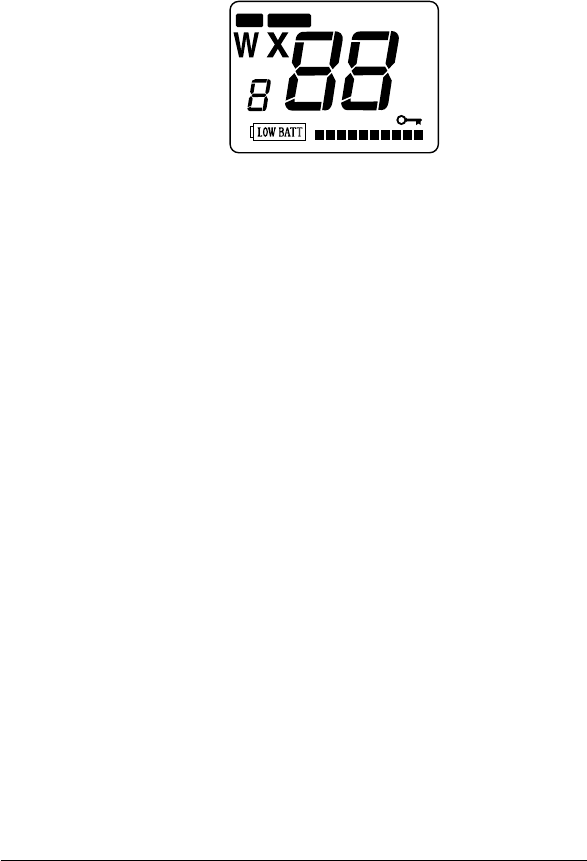
page 8 Owner’s Manual HX260S
3.2 INDICATORS
Channel Display
Displays the operating channel in both transmission and reception mode.
A Indicator
A simplex channel in USA or Canadian mode whose counterpart in the
International mode is a duplex channel.
TX/ BUSY Indicator
“TX” shows the radio is transmitting . “BUSY” shows the radio is
receiving.
USA/ INTL/ CAN Indicator
The modes of operation for the particular channel. “USA” indicates USA
mode. “INTL” indicates International mode and “CAN” indicates
Canadian mode.
WX Indicator
A NOAA weather channel.
MEM Indicator
Shows the channel is in the transceiver's scan memory.
H/L Indicator
“H” is high power. “L” is low power. Blank is a reception only channel.
SQL Indicator
“SQL” is squelch adjusting mode.
MEM
MEM
A
HL
SD
I NTL
TL
USA
USA
CAN
CAN
SQL
SQL
BUSYTX
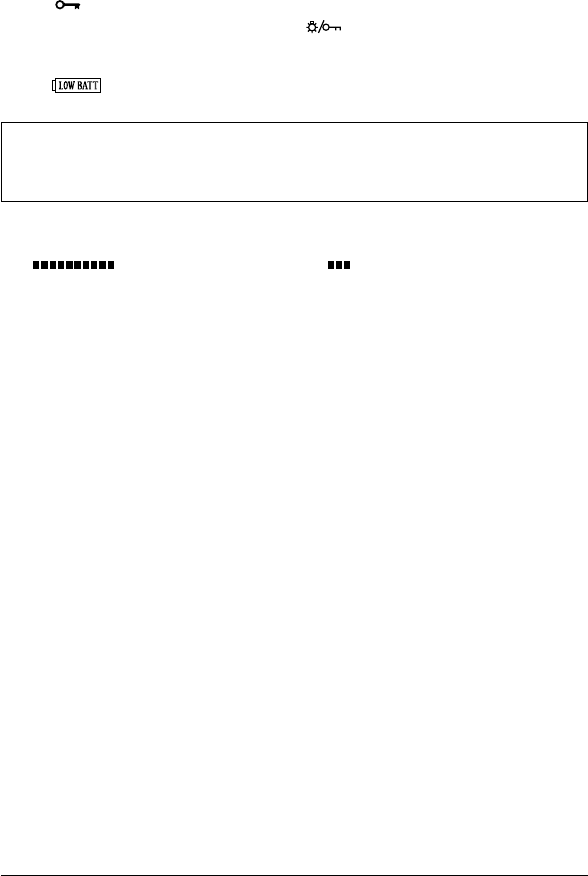
HX260S Owner’s Manual page 9
Key Lock Symbol
A “ ” appears when the channel is locked. All keys are disabled
except for the H/L, PTT, PWR and (lamp/key lock) keys.
Low Battery Indicator
A “ ” appears when the battery capacity is less than 10%.
NOTE
The battery indicator should be used only as a guide to indicate the
CNB260 needs to be charged. See section 5 for proper battery
charging.
Output Power Indicator
“ ” is high (5 watts) power. “ ” is low (1 watt) power.
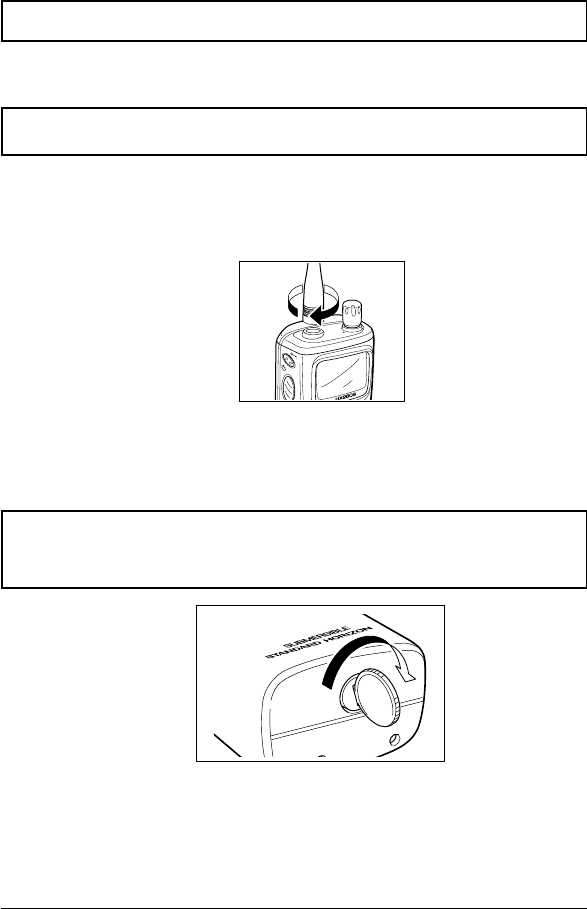
page 10 Owner’s Manual HX260S
4 OPERATION
4.1 INITIAL PROCEDURE
NOTE
Never key the transceiver without an antenna connected. Damage may
occur to the transceiver. Do not operate the transceiver while charging.
1. To remove the belt clip, pull the stopper and slide the belt clip upwawrd.
2. Install the nylon carrying strap on the belt clip if desired.
3. Install the battery pack on the transceiver. (see figure 4 and section 5.2)
4. Install the antenna to the transceiver.
5. Turn the POWER /VOLUME CONTROL knob clockwise to turn the
transceiver on. NOTE
Water resistance of the transceiver is assured only when the battery
pack and antenna are attached to the transceiver.
Turn the battery lock screw clockwise 1/4 turn to tighten.
VOL
OFF
Figure 3. Antenna Installation
LOCK
OPEN
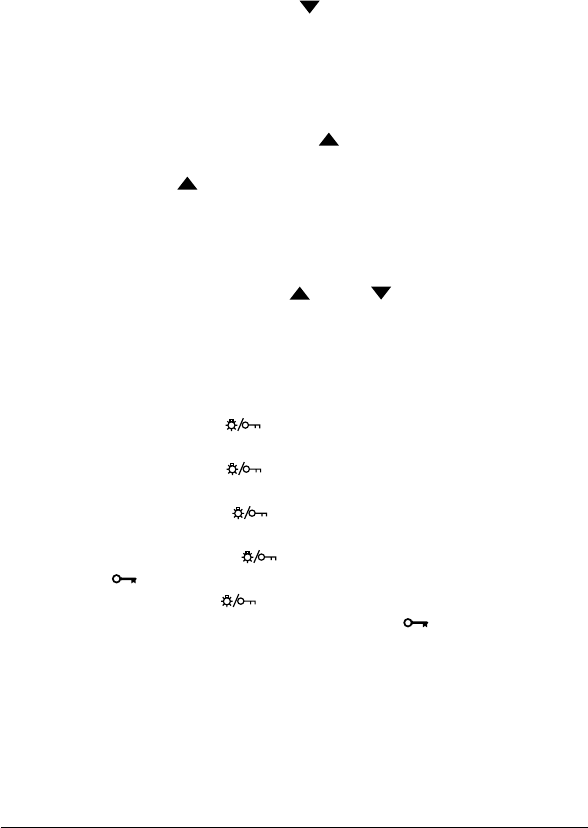
HX260S Owner’s Manual page 11
4.2 RECEPTION
1. Turn the POWER /VOLUME CONTROL knob clockwise to turn the
transceiver on.
2. Press the SQL key, then press (Down) key until squelch level is
minimum. This state is known as squelch off.
3. Select a channel that has no signal being received (no one is
transmitting on the channel) and only noise is heard.
4. Turn up the POWER /VOLUME CONTROL knob until the noise or
audio from the speaker is at a desired level.
5. Press the SQL key, then press the (Up) key and stop immediately
after the noise disappears. This condition is known as the “Squelch
Threshold”. If the (Up) key pressed beyond this level, weak signals
may not be received. No signal can be heard until a signal is received
that exceeds the squelch threshold. The SQUELCH ADJUSTMENT
mode will automatically turn off in about 5 seconds. To turn off the
SQUELCH ADJUSTMENT mode immediately, press the SQL key.
6. To change channels, press the (Up) or (Down) key. Sometimes,
a slight adjustment of the squelch threshold is needed as some
channels have a higher noise level than others.
Please refer to the Owner’s Manual Supplement for a complete listing
of all USA, International and Canadian VHF Marine channels and their
use.
7. If necessary, press the (Lamp/key lock) key to turn on the lamp.
The lamp automatically turns off in about 5 seconds. To turn off the
lamp sooner, press the (Lamp/key lock) key again.
8. To lock the channel in the operating mode so that it is not accidentally
changed, hold down the (Lamp/key lock) key for about 1 second.
This locks the UP and DOWN keys and all front panel controls except
the H/L, PTT, SQL and (Lamp/key lock) keys. The key lock
symbol “” appears on the display to indicate that the channel is
locked. Hold down the (Lamp/key lock) key for about 1 second to
unlock the channel. The key lock symbol “ ” disappears from
display.

page 12 Owner’s Manual HX260S
4.3 TRANSMISSION
1. Perform steps 1 through 7 of RECEPTION.
2. Before transmitting, monitor the channel and make sure it is clear.
THIS IS AN FCC REQUIREMENT!
3. For communications over short distances, press the H/L key until “L” is
displayed on the LCD. This indicates low power, approximately 1 watt.
NOTE
Transmitting on 1 watt prolongs battery life. Low power (1 watt) should
be selected whenever possible.
4. If using low power is not effective, select high power (5 watts) by
pressing the H/L key until “H” is displayed.
5. When receiving a signal, wait until the signal stops before transmitting.
The transceiver cannot transmit and receive simultaneously.
6. Press the PTT (push - to - talk) switch. The TX indicator is displayed
during transmission.
7. Speak slowly and clearly into the microphone. Hold the microphone
about 1/2 to 1 inch away from your mouth.
8. When the transmission is finished, release the PTT switch.
9. Refer to the OWNER’S MANUAL SUPPLEMENT for standard
transceiver operating procedures.
4.4 TRANSMIT TIME - OUT TIMER (TOT)
While the PTT switch is held down, transmission time is limited to 5
minutes. This prevents prolonged unintentional transmissions. About 10
seconds before automatic transmitter shutdown, a warning beep is
sounded from the speaker. The transceiver automatically switches to the
receiving mode, even if the PTT switch is held down. Before transmitting
again, the PTT switch must first be released and pressed again. This time-
out timer (TOT) prevents a continuous transmission that would result from
an accidentally stuck PTT switch.
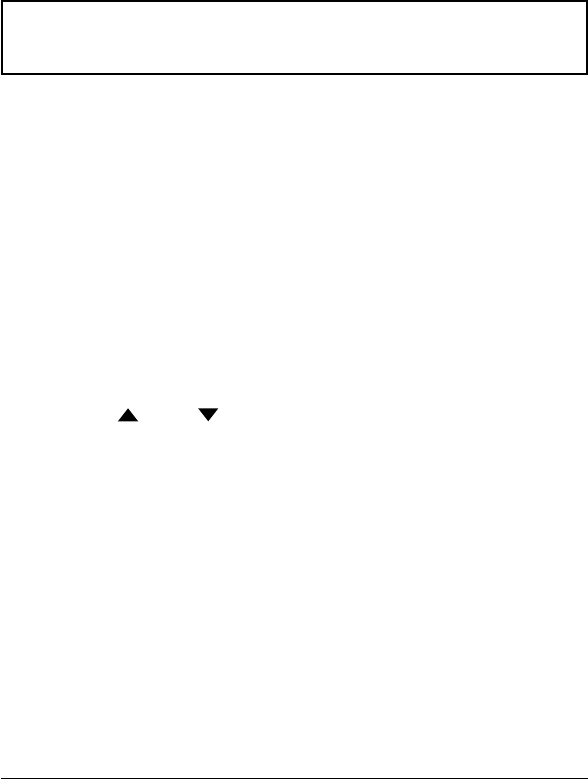
HX260S Owner’s Manual page 13
4.5 SIMPLEX/DUPLEX CHANNEL USE
Refer to the OWNER’S MANUAL SUPPLEMENT for instruction on use of
simplex and duplex channels.
NOTE
All channels are factory-programmed in accordance with FCC (USA),
Industry Canada (Canada), and International regulations. Mode of
operation cannot be altered from simplex to duplex or vice-versa.
4.6 USA, CANADA, AND INTERNATIONAL MODE
1. To change the modes, press and hold the 16/9 key and press the WX
key. The mode changes from USA to International to Canada with
each press of the WX key.
2. “USA” will be displayed on the LCD for the USA mode, “INTL” will be
displayed for International mode, and “CAN” will be displayed for
Canadian mode.
3. Refer to the OWNER’S MANUAL SUPPLEMENT for allocated
channels in each mode.
4.7 NOAA WEATHER CHANNELS
1. To receive a NOAA weather channel, press the WX key from any
channel. The transceiver will go to the last selected weather channel.
2. Press the (Up) or (Down) key to select a different NOAA weather
channel.
3. To exit from the weather channels, press the WX key. The transceiver
returns to the channel it was on prior to weather channel.
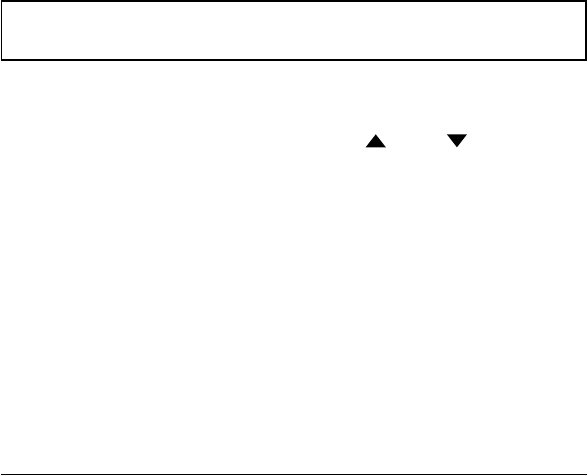
page 14 Owner’s Manual HX260S
4.8 WEATHER ALERT
In the event of extreme weather disturbances such as storms and
hurricanes, NOAA (National Oceanic and Atmospheric Administration)
sends a weather alert accompanied by a 1050 Hz tone and subsequent
weather report on one of the weather channels. The transceiver is capable
of receiving this alert if the following is performed:
1. Program NOAA weather channels into the transceiver’s memory for
scanning. Follow the same procedure as for regular channels under
Section 4.9.
2. Press the SCAN key once to start memory scanning.
3. The programmed NOAA weather channels will be scanned along with
the regular-programmed channels. However, scanning will not stop on
a normal weather broadcast unless a NOAA alert is received.
4. When the weather alert is received on a weather channel, scanning
will stop and the transceiver will emit a loud intermittent beep to alert
user of a NOAA broadcast.
5. Press the WX key to stop the alert tone and receive the weather
report.
NOTE
If the WX key is not pressed the alert tone will be emitted for 5 minutes
and then the weather report will be received.
4.9 MEMORY SCANNING
1. Adjust a squelch level until background noise disappears. Select a
desired channel to be scanned using the (Up) or (Down) key.
2. Press and hold down the SCAN key, “MEM” will appear in the LCD
indicating that the channel has been added to the transceiver’s
memory.
3. Repeat step 2 for all the desired channels to be scanned.
4. To DELETE a channel from the transceiver’s memory. Press and hold
down the SCAN key, “MEM” will disappear from the LCD, indications
the channel has been deleted from scan memory.
5. To start scanning, press the SCAN key. Scanning will proceed from
the lowest to the highest programmed channel number and will stop
on a channel when a transmission is received.
6. To stop scanning, press the SCAN, 16/9, WX , or PTT key.

HX260S Owner’s Manual page 15
4.10 DUAL WATCHING
To start dual watching, select a channel other than CH16 or NOAA weather
channels and press the DW key. The “d” will appear in the LCD. This
operation monitors CH16 while you are receiving the selected channel.
a) If a signal is received on CH16, dual watch pauses on CH16 until the
signal disappears.
b) If a signal is received on the selected channel, the radio will operate
dual watching between CH16 and the selected channel.
4.11 EMERGENCY CHANNEL 16
1. To select the emergency channel, press the 16/9 key from any
channel.
2. Transmit your emergency signal in the same manner as on regular
channels. If you cannot contact anyone on channel 16, switch to
another channel.
3. See the OWNER’S MANUAL SUPPLEMENT for additional emergency
operating practices.
4. To recall the previous channel from 16, press the 16/9 key.
4.12 CHANNEL 9
Channel 9 is used as a hailing channel for initial, non-emergency contact
with other vessels. To select, hold down the 16/9 key until channel 9
appear on the display.
4.13 OPERATING ON CHANNEL 13
Channel 13 is used at docks, bridges and for maneuvering in port.
Messages on this channel must concern navigation only, such as meeting
and passing in restricted waters.
In emergencies and when approaching blind river bends, high power is
allowed. Press the H/L key to temporarily switch to high power before
transmitting. High power can only be accessed in USA and Canadian
modes. When the PTT switch is released, the transceiver will revert low
power.

page 16 Owner’s Manual HX260S
4.14 OPERATING ON CHANNEL 67
When channel 67 is used for navigational bridge-to-bridge traffic between
ships, high power may be used temporarily in the USA mode by pressing
the H/L key before transmitting. When the PTT switch is released, the
transceiver will revert low power.
4.15 RESETTING THE TRANSCEIVER’S
MICROPROCESSOR
Resetting the microprocessor restores the initial, factory supplied
conditions in the transceiver. These are called the default conditions. To
reset the microprocessor, first turn the transceiver off. Then while pressing
and holding the WX and SCAN keys, turn the transceiver on. The default
conditions are:
• No channel numbers are in SCAN memory.
• Channel 16 will be selected when the transceiver is turned on.
• WX channel 01 will be recalled when the WX key is pressed.
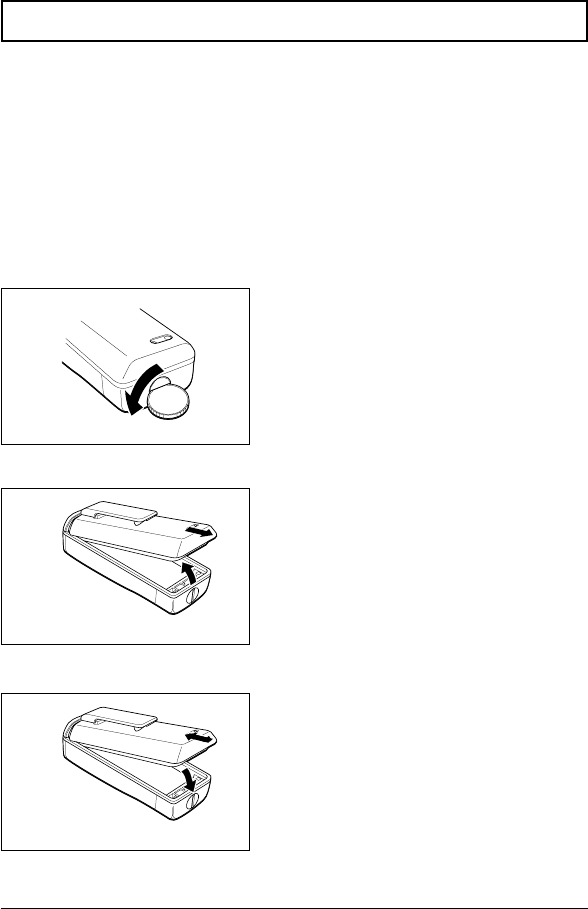
HX260S Owner’s Manual page 17
5 BATTERY
5.1 BATTERY CHARGING
To check the charge status, install the battery and press the PTT switch
while observing the BATT indicator. (see page 9)
The CWC260 battery charger supplied with the transceiver recharges a
completely discharged CNB260 battery pack in about 15 hours.
Battery pack should not be charged with the supplied battery charge
system for longer than 16 hours.
Show figure 9 how the charger plugs into the battery.
5.2 BATTERY PACK REMOVAL/INSTALLATION
1. Turn the transceiver off.
2. Turn the battery lock screw counter-
clockwise 1/4 turn.
3. Pull the battery pack to upward and
remove the battery pack.
4. Attach the battery pack to transceiver.
5. Turn the battery lock screw clockwise
1/4 turn.
Figure 4. Turning the battery lock
LOCK
OPEN
Figure 5. Removing the battery pack
Figure 6. Attaching the battery pack
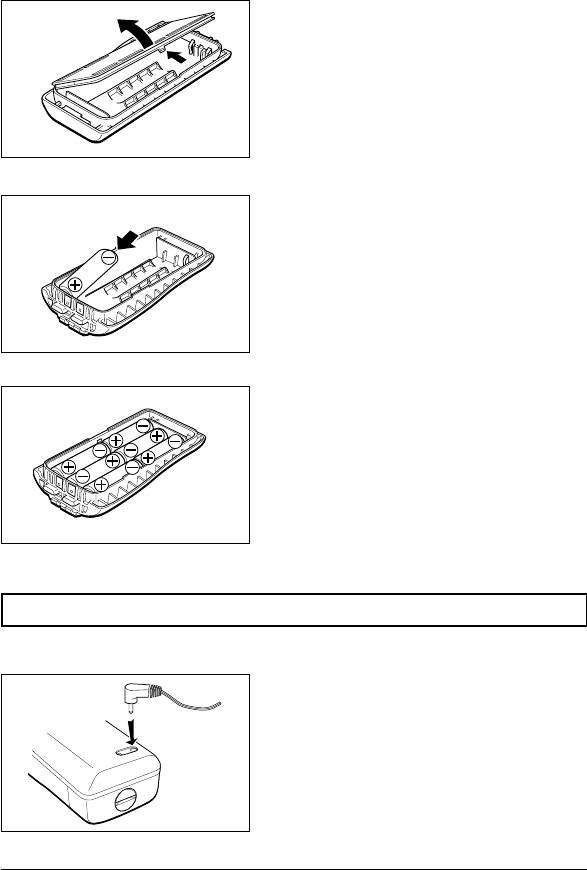
page 18 Owner’s Manual HX260S
5.3 USING BATTERY TRAY
1. Push the lock of the battery tray, and
open the lid.
2. Install the AA battery sell.
(We recommend you use alkaline
battery.)
3. Confirm the polarity of the batteries.
4. Close the lid.
5. Attach the battery tray to transceiver,
and turn the lock screw clockwise 1/4
turn.
CAUTION
Never use Ni-Cd batteries or other rechagable batteries.
5.3 OPERATING CWC260 BATTERY CHARGER
1. Turn the transceiver off.
2. Plug the DC plug of CWC260 into the
battery.
3. Plug the wall charger into a 120 VAC
wall outlet.
4. The indicator lights, and charging begins.
5. Remove the DC plug from the battery
when charging time has passed.
Figure 7. Installing the battery pack
Figure 6. Removing the battery case lid
LOCK
OPEN
Figure 9. Pluging the DC plug
Figure 8. Confirm the polarity

HX260S Owner’s Manual page 19
Ni - Cd
5.4 BATTERY SAFETY
Battery packs for your transceiver contain Nickel-cadmium (Ni-Cd)
batteries. This type of battery stores a charge powerful enough to be
dangerous if misused or abused, especially when removed from the
transceiver. Please observe the following precautions:
DO NOT SHORT BATTERY PACK TERMINALS
Shorting the terminals that power the transceiver can cause sparks, severe
overheating, burns, and battery cell damage. If the short is of sufficient
duration, it is possible to melt battery components. Do not place a loose
battery pack on or near metal surfaces or objects such as paper clips, keys,
tools, etc. When the battery pack is installed on the transceiver, the
terminals that transfer current to the transceiver are not exposed. The
terminals that are exposed on the battery pack when it is mounted on the
transceiver are charging terminals only and do not constitute a hazard.
DO NOT OVERCHARGE
Do not charge the transceiver for more than 16 hours with the battery
charge system. Heat generated by overcharging can shorten battery life
and cause other battery pack component failures.
DO NOT INCINERATE
Do not dispose of any Ni-Cd battery in a fire or incinerator. The heat of fire
may cause battery cells to explode and/or release dangerous gases.
DISPOSE OF BATTERY PACKS PROPERLY
Ni-Cd batteries must be recycled or disposed of properly. For requirements
in your area, check with the dealer from whom you purchased your
transceiver. The symbol shown below is a reminder that the battery packs
are recyclable.

page 20 Owner’s Manual HX260S
6 MAINTENANCE
For preventive maintenance and instructions on obtaining factory service,
please refer to the OWNER’S MANUAL SUPPLEMENT. For general
troubleshooting, refer to this Troubleshooting Chart.
TROUBLESHOOTING CHART
PROBABLE
CAUSE
No channels
memorized.
Squelch is not
adjusted.
Proper operation
not followed.
Low battery.
Key Lock is on.
Proper operation
not followed.
Defective battery,
CWC231.
SYMPTOM
The SCAN key
does not start the
scan.
The USA/INTL/CAN
modes do not
function.
Rotating the
squelch control
does not eliminate
background noise.
Cannot change any
function.
does not
function.
LED on CWC231
does not light when
charging a battery.
REMEDY
Use the MEM key to enter
desired channels into the
transceiver’s memory.
Adjust the squelch to thres-
hold or to the point where
noise just disappears. Further
adjustment of the squelch
control may eliminate
incoming signals.
Hold down the 16/9 key and
press the WX key.
Charge battery. Refer to
section 5 of this manual.
Turn Key Lock off.
Hold down for until is
displayed.
Contact your STANDARD
HORIZON dealer or STANDARD
HORIZON for servicing.

HX260S Owner’s Manual page 21
7 SPECIFICATIONS
Performance specifications are nominal, unless otherwise indicated, and
are subject to change without notice.
7.1 GENERAL
Channels ................................. All currently allocated USA, Canadian and
International channels, plus 10 weather channels.
RF Power Output with CNB260 Battery .................... 5.0 W
(high)
1.0 W
(low)
Operating Voltage ......................................................................... 7.2 VDC
Current Drain:
Standby ..................................................................................... 45 mA
Receive ................................................................................... 200 mA
Transmit ................................... 1.8 A (high power), 0.7 A (low power)
Dimensions...............................................5.51” H x 2.17” W x 1.50” D
(135.0 mm x 61 mm x 41 mm)
Weight ...........................................................................1.0 Ib. (0.5Kg)
FCC Type Acceptance Number .......................................K66HX260S
Industry Canada Type Approval Number ............................ PENDING
Battery Life(5% TX, 5% RX, 90% Standby) ..................... 8 hrs. (high)
10 hrs. (low)
7.2 TRANSMITTER
Frequency Range ............................................... 156.025 to 157.425 MHz
Conducted Spurious Emissions ............................ Less than 60 dB (high),
Less than 50 dB (low)
Audio Response ........................ within +1/-3 of 6 dB/octave pre-emphasis
characteristic from 300 Hz to 3000 Hz
AF Harmonic Distortion ........................................................ Less than 3 %
Hum and Noise ................................................................ More than 40 dB
Frequency Stability (-20° to +50°C) .......................................... +/- 10 ppm
7.3 RECEIVER
Frequency Range ............................................... 156.025 to 163.275 MHz
Sensitivity:
20 dB Quieting ........................................................................ 0.30 µV
12 dB SINAD ........................................................................... 0.20 µV
Squelch Sensitivity (Threshold) ..................................................... 0.20 µV
Modulation Acceptance Bandwidth ........................................... +/- 4.5 kHz
Selectivity:
Spurious and Image Rejection .................................. More than 60 dB
Intermodulation Rejection ......................................... More than 60 dB
Channel Spacing ...................................................................... 25 kHz

YAESU U. S. A.
17210 Edwards Rd., Cerritos, CA 90703, U.S.A.
Printed in China
07/00 451X851010